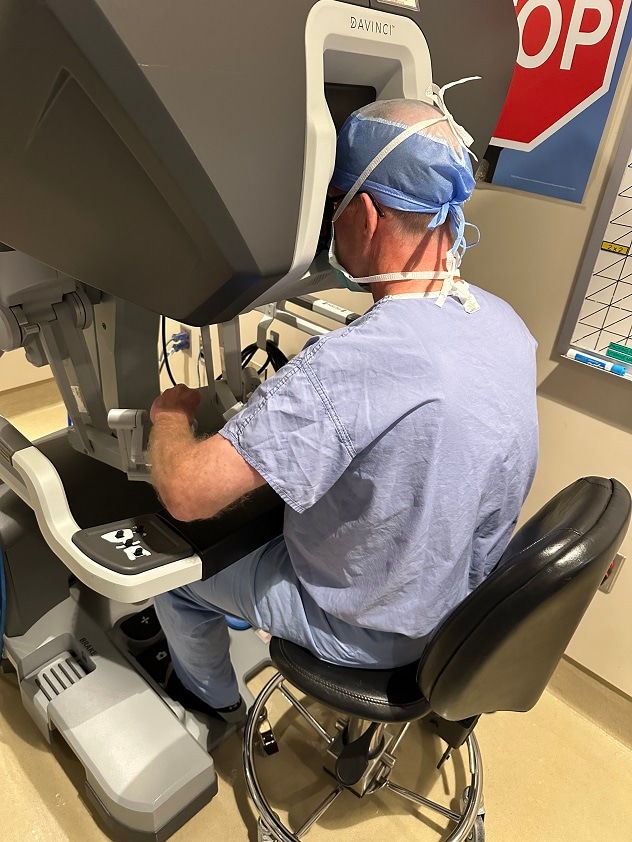November 30, 2023
Mayo Clinic surgeons have successfully performed Minnesota’s first robot-assisted kidney transplant. This minimally invasive procedure is beneficial for patients with a high BMI and reduces the risk of incisional complications.
Timsyn Tanner, MD, chief of transplant surgery at Mayo Clinic in Minnesota, and kidney transplant surgeon Patrick G. Dean, MD, performed the robot-assisted surgery. The recipient was a woman in her 60s whose kidney was donated by her daughter.
Beyond its uniqueness in the state, this patient’s robotic kidney transplant was the first of its kind at a Mayo Clinic facility. Mayo Clinic in Minnesota plans to expand the availability of robotic kidney transplants in the future, and Mayo Clinic in Arizona is exploring the possibility of this type of transplant.
Characteristics of robotic kidney transplantation

surgical robot
Dr. Patrick G. Dean sits at a console controlling a surgical robot.
When transplanting a kidney using robotic surgery, the surgeon stands over the surgical field and reaches directly into the patient’s body to perform tasks such as suturing and tying directly. The surgeon sits at a console and controls the surgical robot, making small incisions and inserting instruments through ports, similar to laparoscopic surgery. However, surgical assistants touch the patient and manipulate instruments inside the patient’s body.
For patients, robot-assisted kidney transplantation offers the following benefits:
- smaller incisions. For this type of implant, the surgeon makes an approximately 2-inch incision around the belly button and then makes an even smaller incision to insert the robotic instrument. In a traditional open kidney transplant, the surgeon makes a 4- to 8-inch incision.
- Lower incision option for cosmetic purposes. Robotic surgery offers the option of making smaller incisions than those used for open kidney transplant surgery.
- Low risk of complications. Robot-assisted kidney transplants require minimal incisions, reducing the risk of complications such as hernias and infections.
- Faster recovery. Smaller incisions with robot-assisted implantation mean that patients have fewer healing areas, faster recovery time, and faster return to work and activities of daily living.
- Reduced discomfort and hospitalization. This surgical technique uses smaller incisions, resulting in less discomfort for the patient. Because of the reduced discomfort and faster recovery time, patients are usually able to leave the hospital faster than with open kidney transplants.
For surgeons performing kidney transplants, robot-assisted transplantation offers the following benefits:
- It saves you from standing for hours during surgery. In robotic surgery, the surgeon works while sitting at a console rather than standing over the patient in the surgical field. A literature review published in 2015 in Rehabilitation Nursing found significant evidence that prolonged standing is associated with multiple health risks. Surgeons can avoid these health risks if they undergo robotic implantation while seated.
- Visualization. This type of surgery allows the surgeon to obtain a better view compared to using only the eyes.
“Robot-assisted kidney transplantation is not a complete replacement for open kidney transplantation, but it may be another option for those who may benefit from an alternative incision site.”
Patients suitable for referral for robotic kidney surgery
For most patients, traditional open kidney transplant surgery remains the best option, Dr. Tanner said, and this type of kidney transplant has been shown to be safe and successful.
“Open kidney transplantation remains the gold standard,” Dr. Tanner says. “Robot-assisted kidney transplantation is not a complete replacement for open kidney transplantation, but it may be another option for those who may benefit from an alternative incision site.”
Dr. Dean and Dr. Tanner believe that the patients who are most likely to benefit from robotic kidney transplantation and are suitable for referral to Mayo Clinic are those with a high body mass index, especially those who carry weight in their mid-torso region. We assume that. When a patient’s body habits require open surgery to penetrate very deep into the abdomen, robotics can help circumvent that surgical challenge by improving visualization. Incision complications can be avoided because the incisions in robotic surgery are smaller and recovery is faster and easier.
Robotic kidney transplant training
Dr. Dean, Dr. Tanner, and two of their colleagues spent approximately six months training in robotic kidney transplant surgery. They participated in numerous simulations using videos, mannequins, animal models, and deceased donors. These various practice sessions allowed them to become familiar with the procedure and become comfortable with it, Dr. Tanner says, allowing them to perform it in human transplants.
Potential future of robotic kidney transplantation
Dr. Dean believes robotic kidney transplants will become more common in the coming years, especially as more equipment becomes available for these procedures.
“I don’t think robotic surgery will ever make up the majority of kidney transplants, because certain patient characteristics may not make it the most preferred option,” Dr. Dean says. “I think robotic kidney transplants will continue to increase, and this is something we’ve seen nationally in the last few years.”
For more information
Waters TR et al. Evidence of health risks associated with prolonged standing and effectiveness of interventions. rehabilitation nursing. 2015;40:148.
Refer the patient to Mayo Clinic.

